A Short History of Mechanical Engineering at RMC
- The Engineering Context when RMC opened in 1876
- World War I
- Mechanical Engineering after World War II
- Degree Granting Status
- Departmental Facilities
- Major Projects Undertaken in the Past
- Modern Research Projects
- Engineering & Management
- Bilingualism in Mechanical Engineering
- Aeronautical Engineering
The following material is based on draft sections of a book on the history of Mechanical Engineering at RMC, currently being written under the sponsorship of the Cordite Foundation.
The Engineering Context When RMC Opened in 1876
When the College opened, Engineering was divided into only two subsets: Military Engineering and Civil Engineering. The distinction was primarily based on the operational environment rather than the technology itself. Thus, topics that we would now consider to be within the practice of Mechanical Engineering were originally part of Civil Engineering.
A small number of US universities were beginning to offer degree programmes specifically in Mechanical Engineering at that time, but they were the exception. Even the broader category of Civil Engineering was only beginning to be offered under its own name. The first Engineering degrees in Canada were awarded by McGill University two years after the college opened in 1876.
When RMC opened its doors to its first students (referred to as the Old Eighteen), military technology, engineering practice, and the education of engineers were undergoing major changes and evolving rapidly. During the preceding 20 years, breech-loading guns, brass cartridges, Gatling guns and iron hulled warships had first appeared. Only recently had kerosene replaced whale oil as the primary fuel for lamps and the lubricant for industry. Nicholas Otto produced the first 4 stroke internal combustion engine the year RMC opened, and Canada itself was just nine years old.
The new military college was aimed at providing a rigorous four year programme attuned to the rapid technological evolution that was under way. However, at that time, there was no Canadian Navy and powered flight was still a dream for the future. Consequently, it was a land-oriented institution, and the military and academic programmes reflected the Army needs of the time. There were very few billets available for new officers in the Army, so it was intended that most College graduates would join civilian industry and thereby contribute directly to the growth of the burgeoning Canadian economy. The program included mathematics, engineering drawing and mechanics, as well as other engineering-oriented topics that formed part of the Chemistry and Physics curriculum. As the first decades of the Twentieth Century progressed, more Mechanical Engineering subjects, including thermodynamics and strength of materials, appeared as core elements in the programme.
World War I
During WW I the College programme was shortened to as little as one year in order allow cadets to join the fighting in Europe. After the Armistice in 1918 a three year programme was implemented. In 1919 the Commandant, Major General Sir A.C. MacDonnell, returned the course to its original length of four years.
For much of the 1920s and 1930s, RMC cadets who graduated with good marks would be allowed into the fourth and final year of an engineering programme at various degree-granting civilian universities.
In 1928, a new engineering laboratory, the Machinery Building, was constructed.. This was a significant step in recognizing the importance of engineering in the military and freeed up space in the basement of Currie Hall for a new drafting room.
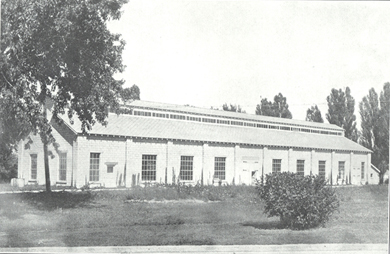 New Mechanical Laboratory built in 1928
New Mechanical Laboratory built in 1928Although all cadets took the same general course in their first years at RMC, greater specialization was introduced in the 1930s. By the end of that decade, there was a general course for all cadets in the first three years and the final year allowed for specialization in Mechanical, Electrical or Civil Engineering.
As had been the case in WWI, when WWII began in 1939 the College shortened the cadet programme to permit early graduation. It then closed entirely for cadets in 1942.
RMC Engineering after World War II
When the College reopened in 1948, its basic structure was identical to that of the pre-war period i.e. it was a private school run by the Department of National Defence under a Royal Charter. However, , its vision and goals differed in two significant ways from those of the pre-war RMC.
First, unlike the exclusively Army orientation that existed before the war, the new RMC was based on a Tri-Service concept. Candidates were enrolled in the Army, Navy or Air Force and undertook summer training with their particular branch of the Forces. However during the College year there was no service-related differentiation among the cadets; for example all wore the same RMC uniforms. Over the years there have been changes in the realization of the Tri-Service vision, but the basic goal of making the College experience relevant to all branches of the Forces still stands.
The other significant departure from pre-war RMC was manifested in the new academic programs, which were established to parallel those at civilian universities. In addition to Arts and Science curricula, the College offered Mechanical, Civil, Chemical, and Electrical Engineering courses similar to those at Canadian Universities. However, as a federal institution in a country whose constitution gave educational authority to the provinces, RMC granted only diplomas, not degrees to the first seven postwar graduating classes. Consequently, many RMC graduates from that era went on to study one more year at a Canadian civilian university in order to earn their Bachelor's Degrees in Engineering.
Degree Granting Status
In 1959 RMC was granted degree-granting status by the province of Ontario and the first arts and science degrees were awarded that year. Implementing the required curriculum changes to meet professional standards resulted in the first engineering degrees being conferred in 1962. The first RMC Master's degree was awarded in 1966 (to a Mechanical Engineer) and in 1995, RMC conferred its first PhD.
Departmental Facilities
For most of the three decades following the re-opening of the College in 1948, the Mechanical Engineering Department's main laboratory and offices were in the concrete block structure originally built as the Machinery Building in 1928. However, like several other departments, it also occupied space in a number of other buildings on the College grounds , including a dedicated drafting building, a machine shop near Highway 2, and a jet engine test cell outside the ramparts on Point Frederick. At one time, its facilities and staff were housed in as many as eight different buildings.
 Main Mechanical Engineering Laboratory & Offices 1950-1974 (Prior to demolition in 1974 to make way for completion of the Sawyer Building)
Main Mechanical Engineering Laboratory & Offices 1950-1974 (Prior to demolition in 1974 to make way for completion of the Sawyer Building)The construction of the Sawyer Building in 1972-1977 brought all the teaching staff and most of the laboratory facilities under one roof, with the exception of the large machine shop and the jet test cell.
Major Projects Undertaken in the Past
In the 1950s projects tended to be very applied and were aimed at specific military needs.
For example, a small submersible vessel was designed and built in the department in the early 1950s. The boat was intended to be a prototype inspection craft to examine ship hulls and propulsive gear from underwater. It was driven by a modified torpedo motor- a radial compressed-air motor, adapted for the purpose by department members. The concept for the boat was deemed to be highly creative, but it never entered production and after completion of the test program, it was broken up and disposed of in Navy Bay, adjacent to the College grounds. Portions of her hull were recovered by scuba divers in the summer of 2000 but were ultimately returned to Navy Bay.
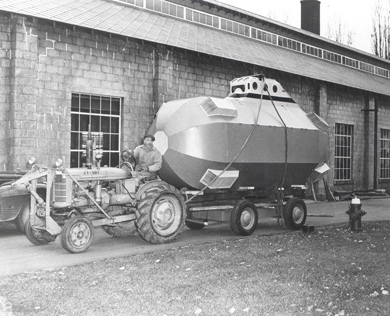 Submersible Craft completed in 1953
Submersible Craft completed in 1953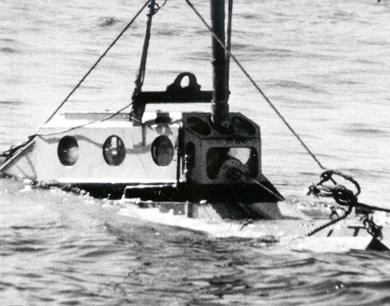 Submarine undergoing tests
Submarine undergoing testsDuring the mid 1950s, the motor vessel M.V. CORDITE was designed and constructed by Mechanical Engineering staff. This was the first all-welded aluminum vessel built in Canada; the material was donated by ALCAN and the inert gas welding technology used in her construction was a revolutionary technology at the time. As part of her novel construction, CORDITE incorporated a closed circuit cooling system, in which hollow hull stiffeners were also used as coolant passages. The bottom of the vessel thus served as a heat exchange surface to transfer excess heat from her twin diesel engines to the lake water. Kort nozzles were included in the design; these innovative hydrodynamically-designed shrouds which surrounded the propellers significantly increased propeller thrust and lowered fuel consumption. CORDITE is still used for undergraduate laboratory experiments in the department.
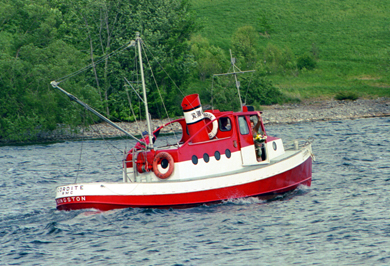 MV Cordite launched in 1956 - designed and built by the Department
MV Cordite launched in 1956 - designed and built by the DepartmentA small runabout hull was constructed in the early 1960s. Dubbed SHRAPNEL, it was used to demonstrate the use of hydrofoils, and was later converted to a water-jet drive of the type used on present day personal water craft. The propulsion system was driven by a late 1950s fuel-injected V-8 engine from a Chevrolet Corvette sports car.
Modern Research Projects
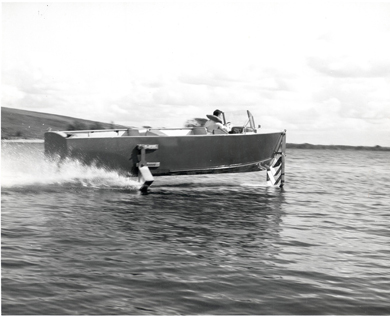 Hydrofoil SHRAPNEL under test - 1962
Hydrofoil SHRAPNEL under test - 1962Many other research projects have been carried out by the department faculty over the past 50 years. Nowadays, these are usually smaller scale fundamental studies, rather than the large design projects of the 1950s. As well as normal research grants received by professors through the National Sciences and Engineering Research Council (NSERC), research at RMC has often been funded by Defence sponsors. These have included the Defence Research Board (DRB), its successor, the Chief of Research & Development branch of the Forces (CRAD) and, latterly, the Defence Research & Development Agency (DRDA). The projects have covered a vast array of topics, always related to the expertise and research interests of the professors in the department at the timeand of relevance to the needs and goals of the Canadian Forces . They have included continuously-variable transmissions using non-circular gears, heat transfer in permafrost, the fluid dynamics of unsteady flows in axial compressors, combustion of alternative fuels, gas turbine and piston engine performance, fatigue in aircraft structures, robotics, biomedical engineering, aircraft stability and control and tribology, among others.
Engineering & Management
It was the experience of many newly-graduated engineering officers that they often moved quickly from purely technical jobs into management. T Engineering expertise and an understanding of the capabilities, operation and limitations of technical equipment were still needed butmanagement of these assets and the personnel who used and supported them frequently became the primary focus. In response to this need, an undergraduate program in Engineering and Management was initiated in 1966 and for administrative purposes this program, and the two full-time faculty members associated with it, came under the aegis of the Mechanical Engineering Department.
The program itself followed the common core that all engineers took in the first two years, and in the Third and Fourth years included roughly half of the courses that the Mechanical Engineers took. The remaining content was focussed primarily on quantitative aspects of management, including such subjects as statistics, operations research, production methods, quality control, inventory management, etc. The first E&M graduates marched off the parade square in 1968.
The programme grew significantly during the 1970s and 80s and moved out from under the Mechanical Engineering umbrella in 1982, becoming the autonomous Engineering & Management Department. The programme flourished until 1995 when it was closed down in an NDHQ-directed reorganization aimed at reducing the number of engineering degree programmes at RMC. This coincided with the closure of the other two Canadian Military Colleges, Royal Roads in Victoria, BC and Collège Militaire Royal in St-Jean, QC. At that time, many of the faculty, whose numbers had grown significantly over the years, were transferred to the Arts Division and became the core of the new Department of Business Administration. The last E &M graduates marched off the square in 1996.
Bilingualism in Mechanical Engineering
A high-level decision was made in the mid-1970s to offer all engineering programmes in both official languages. This essentially doubled the number of courses to be offered, requiring a substantial increase in the number of faculty in the Engineering Division at RMC. New faculty hiring for this purpose began in 1976 and courses began to be offered in both languages. Since 1979, undergraduate students have been able to take their entire Mechanical Engineering programme in either language. Some elective courses having small enrolments are offered in only one language but there is always a path if a student wishes to take courses in only English or French. That has continued to be the case to this day.
Aeronautical Engineering
Since the College reopened in 1948, the department has striven to ensure that its efforts reflect the interests of students, the expertise of the faculty and the needs of the Canadian Forces. The submersible and hydrofoil vessels referred to above, and the still-utilized CORDITE are tangible examples of the department's interest in naval technology. Recent investigations of land vehicle dynamics and body-protection armour are clearly of relevance to Canada's land forces. There has also been a strong focus on aero-related technology on the part of both students and faculty in the department. In most years, more than half those graduating in Mechanical Engineering have been enrolled in Air Force officer classifications, ranging from Aerospace Engineer to Pilot and Navigator. This is due, at least in part, to a succession of Air Force officers serving as full time faculty members in the department; these individuals, as well as those from other branches of the Canadian Forces, have brought relevance and awareness of current military technologies not only to the students but to the civilian members of the faculty.
The RCAF (and later) the Air Element of the Canadian Forces has always been a strong supporter of RMC Mechanical Engineering and a wide variety of aero-oriented experimental equipment has been a defining asset of the department for many decades. A large wind tunnel which was constructed immediately following the opening of the Sawyer Building in 1974, an operating turboshaft engine, and a small liquid-fuelled rocket are but a few of the legacies that still form part of the department's inventory. Thanks to the Air Force, the Jet Test Cell referred to above (which was constructed in the mid-1950s and endured for four decades) initially housed a full-scale operating J47 turbojet engine. This was subsequently replaced by an Orenda 10, the engine which propelled the Canadian-built F-86 Sabre Mk5. This facility was unique among Canadian universities and brought immediacy and relevance to both undergraduate labs and advanced research.
Not surprisingly, the legacy continues, and a major portion of funded research in the department has continued to be aero-related; internal and external aerodynamics, fuels and combustion, control systems and advanced materials have been the focus of many of these investigations.
This long term interest in aerospace applications on the part of both the students and staff led to an initiative from within the department in 2003 to create a free-standing program in Aeronautical Engineering. The proposal met with strong support, both from College authorities and senior levels of the Canadian Air Force, and in 2005 a formal agreement was reached to proceed with planning for accredited undergraduate and postgraduate degree programs. A formal structure for funding of aerospace-oriented research was also established.
Accreditation of both the undergraduate and postgraduate programs was duly granted by the respective national and provincial authorities, and in May of 2009 the first graduating class of seventeen Aeronautical Engineers received their BEng degrees from the College.